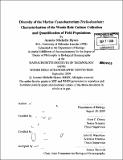| dc.contributor.advisor | Scott C. Doney and John B. Waterbury. | en_US |
| dc.contributor.author | Hynes, Annette Michelle | en_US |
| dc.contributor.other | Woods Hole Oceanographic Institution. | en_US |
| dc.date.accessioned | 2010-04-28T17:03:01Z | |
| dc.date.available | 2010-04-28T17:03:01Z | |
| dc.date.copyright | 2009 | en_US |
| dc.date.issued | 2009 | en_US |
| dc.identifier.uri | http://hdl.handle.net/1721.1/54569 | |
| dc.description | Thesis (Ph. D.)--Joint Program in Biological Oceanography (Massachusetts Institute of Technology, Dept. of Biology; and the Woods Hole Oceanographic Institution), 2009. | en_US |
| dc.description | Cataloged from PDF version of thesis. | en_US |
| dc.description | Includes bibliographical references (p. 149-162). | en_US |
| dc.description.abstract | Trichodesmium is a colonial, N2-fixing cyanobacterium found in tropical oceans. Species of Trichodesmium are genetically similar but several species exist together in the same waters. In order to coexist, Trichodesmium spp. may occupy different niche spaces through differential utilization of resources such as nutrients and light, and through responses to physical characteristics such as temperature and turbulence. To investigate niche differentiation in Trichodesmium, I characterized cultured strains of Trichodesmium, identified and enumerated Trichodesmium clades in the field, and investigated P stress and N2 fixation in field populations. Species of Trichodesmium grouped into two clades based on sequences from 16S rDNA, the internal transcribed spacer (ITS), and the heterocyst differentiation gene hetR. Clade I contained Trichodesmium erythraeum and Trichodesmium contortum, and clade II contained Trichodesmium thiebautii, Trichodesmium tenue, Trichodesmium hildebrandtii, and Trichodesmium pelagicum. Each clade was morphologically diverse, but species within each clade had similar pigmentation. I developed a quantitative polymerase chain reaction (qPCR) method to distinguish between these two clades. In field populations of the Atlantic and Pacific Oceans, the qPCR method revealed that clade II Trichodesmium spp. were more prominent than clade I in the open ocean. Concentrations of Trichodesmium did not correlate with nutrient concentrations, but clade I had wider temperature and depth distributions than clade II. | en_US |
| dc.description.abstract | (cont.) Temperature and light are physical characteristics that may define niche spaces for species of Trichodesmium. Clade I and II concentrations correlated with each other in the Pacific but not in the Atlantic, indicating that the two clades were limited by the same factors in the Pacific while different factors were limiting the abundance of the two clades in the Atlantic. Trichodesmium populations in the North Atlantic were more P stressed and had higher N2 fixation rates than populations in the western Pacific. While nutrient concentrations didn't directly correlate with Trichodesmium concentrations, the contrasting nutrient regimes found in the Atlantic and Pacific Oceans might influence distributions of the two clades differently. Unraveling the differences among species of Trichodesmium begins to explain their coexistence and enables us to understand factors controlling global N2 fixation. | en_US |
| dc.description.statementofresponsibility | by Annette Michelle Hynes. | en_US |
| dc.format.extent | 162 p. | en_US |
| dc.language.iso | eng | en_US |
| dc.publisher | Massachusetts Institute of Technology | en_US |
| dc.rights | M.I.T. theses are protected by
copyright. They may be viewed from this source for any purpose, but
reproduction or distribution in any format is prohibited without written
permission. See provided URL for inquiries about permission. | en_US |
| dc.rights.uri | http://dspace.mit.edu/handle/1721.1/7582 | en_US |
| dc.subject | Joint Program in Biological Oceanography. | en_US |
| dc.subject | Biology. | en_US |
| dc.subject | Woods Hole Oceanographic Institution. | en_US |
| dc.subject.lcsh | Trichodesmium | en_US |
| dc.subject.lcsh | Bacteria Ecology | en_US |
| dc.title | Diversity of the marine cyanobacterium Trichodesmium : characterization of the Woods Hole culture collection and quantification of field populations | en_US |
| dc.type | Thesis | en_US |
| dc.description.degree | Ph.D. | en_US |
| dc.contributor.department | Joint Program in Biological Oceanography. | en_US |
| dc.contributor.department | Woods Hole Oceanographic Institution | en_US |
| dc.contributor.department | Massachusetts Institute of Technology. Department of Biology | |
| dc.identifier.oclc | 567700880 | en_US |
